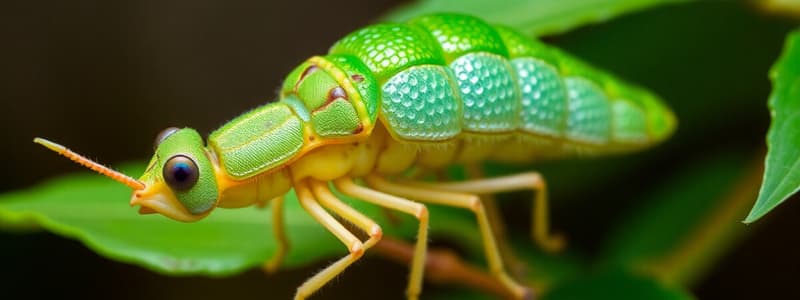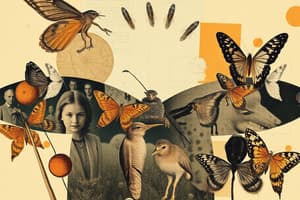Podcast
Questions and Answers
What does the term 'phylogeny' refer to in the context of biology?
What does the term 'phylogeny' refer to in the context of biology?
- The process of natural selection in evolutionary changes
- The evolutionary history and relationships among species (correct)
- The classification of organisms based on physical traits
- The study of ecosystems and their interactions
Which of the following statements best describes the relationship among all living organisms on Earth?
Which of the following statements best describes the relationship among all living organisms on Earth?
- All living organisms are unrelated and evolved independently.
- Living organisms only share similarities if they appear physically similar.
- All living organisms evolved from a common ancestor. (correct)
- Distantly related organisms cannot contribute to the same evolutionary tree.
Why is a comprehensive classification system needed in biology?
Why is a comprehensive classification system needed in biology?
- To eliminate the need for phylogenetic trees.
- To simplify the study of single-celled organisms only.
- To organize the tremendous diversity of life into manageable categories. (correct)
- To create a standard for comparing physical characteristics only.
Which domains of life diverge from a single point according to the phylogenetic tree?
Which domains of life diverge from a single point according to the phylogenetic tree?
What does the study of systematics aim to achieve?
What does the study of systematics aim to achieve?
How can a phylogenetic tree be utilized in biology?
How can a phylogenetic tree be utilized in biology?
What is the primary focus of taxonomic classification in biology?
What is the primary focus of taxonomic classification in biology?
In a phylogenetic tree, what does a branching point indicate?
In a phylogenetic tree, what does a branching point indicate?
What is the primary goal of taxonomy in biology?
What is the primary goal of taxonomy in biology?
Which of the following categories is the most inclusive in the taxonomic classification system?
Which of the following categories is the most inclusive in the taxonomic classification system?
What is the correct order of taxonomic categories from broadest to most specific?
What is the correct order of taxonomic categories from broadest to most specific?
How are genus and species names formatted in scientific nomenclature?
How are genus and species names formatted in scientific nomenclature?
Which of the following groups is not a domain in the taxonomic classification system?
Which of the following groups is not a domain in the taxonomic classification system?
What term describes each group at a level in the taxonomic classification?
What term describes each group at a level in the taxonomic classification?
Which type of data is least likely to be used to construct a phylogenetic tree?
Which type of data is least likely to be used to construct a phylogenetic tree?
What influence do newly discovered species have on the classification system?
What influence do newly discovered species have on the classification system?
What does a phylogenetic tree illustrate?
What does a phylogenetic tree illustrate?
What significant character change is indicated by a branch point in a phylogenetic tree?
What significant character change is indicated by a branch point in a phylogenetic tree?
Which statement about characteristics in phylogenetic trees is true?
Which statement about characteristics in phylogenetic trees is true?
What misconception might someone have about phylogenetic trees?
What misconception might someone have about phylogenetic trees?
What do the branches in a phylogenetic tree represent?
What do the branches in a phylogenetic tree represent?
What is a common example of a character that can differentiate branches in a phylogenetic tree?
What is a common example of a character that can differentiate branches in a phylogenetic tree?
Why might lizards and rabbits appear more similar than lizards and salamanders according to phylogenetic classifications?
Why might lizards and rabbits appear more similar than lizards and salamanders according to phylogenetic classifications?
Which of the following is NOT true about phylogenetic trees?
Which of the following is NOT true about phylogenetic trees?
What is the primary focus of conservation recommendations made in the 2007 study?
What is the primary focus of conservation recommendations made in the 2007 study?
Which method is currently the most accepted for constructing phylogenetic trees?
Which method is currently the most accepted for constructing phylogenetic trees?
What criteria did the 2007 study use to identify lesser-known species for conservation?
What criteria did the 2007 study use to identify lesser-known species for conservation?
What defines a clade in the context of cladistics?
What defines a clade in the context of cladistics?
Why is preserving phylogenetic diversity important in conservation efforts?
Why is preserving phylogenetic diversity important in conservation efforts?
Which species was NOT emphasized for conservation based on their evolutionary distinctiveness?
Which species was NOT emphasized for conservation based on their evolutionary distinctiveness?
What is one misconception regarding the criteria for conservation priorities?
What is one misconception regarding the criteria for conservation priorities?
What do organisms within the shaded regions of a phylogenetic tree represent?
What do organisms within the shaded regions of a phylogenetic tree represent?
What is the primary criterion for identifying the 'best' phylogenetic tree?
What is the primary criterion for identifying the 'best' phylogenetic tree?
Which process involves searching for trees with the simplest evolutionary pathways?
Which process involves searching for trees with the simplest evolutionary pathways?
According to the principles described, what should scientists primarily aim to minimize when creating phylogenetic trees?
According to the principles described, what should scientists primarily aim to minimize when creating phylogenetic trees?
Which unexpected relationship has emerged from recent evolutionary studies?
Which unexpected relationship has emerged from recent evolutionary studies?
What role does DNA sequence information play in phylogenetic studies?
What role does DNA sequence information play in phylogenetic studies?
What defines a shared ancestral character in a clade?
What defines a shared ancestral character in a clade?
How does a shared derived character differ from a shared ancestral character?
How does a shared derived character differ from a shared ancestral character?
What does the concept of maximum parsimony refer to in constructing phylogenetic trees?
What does the concept of maximum parsimony refer to in constructing phylogenetic trees?
Why might a shared derived character not be present in all members of a clade?
Why might a shared derived character not be present in all members of a clade?
What is an implication if a character state appears in two different clades?
What is an implication if a character state appears in two different clades?
How can character changes complicate the construction of phylogenetic trees?
How can character changes complicate the construction of phylogenetic trees?
In what context can a character be categorized as either ancestral or derived?
In what context can a character be categorized as either ancestral or derived?
What role does a computer play in constructing phylogenetic trees from character data?
What role does a computer play in constructing phylogenetic trees from character data?
Flashcards
Phylogenetic Tree
Phylogenetic Tree
A branching diagram that shows the evolutionary relationships among organisms.
Phylogeny
Phylogeny
The evolutionary history and relationships among a species or group of species.
Systematics
Systematics
The study of organisms in order to understand their relationships.
Three Domains of Life
Three Domains of Life
Signup and view all the flashcards
Evolutionary History
Evolutionary History
Signup and view all the flashcards
Common Ancestor
Common Ancestor
Signup and view all the flashcards
Taxonomy
Taxonomy
Signup and view all the flashcards
Phylogenetic Tree Branches
Phylogenetic Tree Branches
Signup and view all the flashcards
Tree of Life
Tree of Life
Signup and view all the flashcards
Linnaean System
Linnaean System
Signup and view all the flashcards
Hierarchical System
Hierarchical System
Signup and view all the flashcards
Domain
Domain
Signup and view all the flashcards
Scientific Name
Scientific Name
Signup and view all the flashcards
Branch Point
Branch Point
Signup and view all the flashcards
Evolutionary Change
Evolutionary Change
Signup and view all the flashcards
Appearance vs. Relatedness
Appearance vs. Relatedness
Signup and view all the flashcards
Branch Length
Branch Length
Signup and view all the flashcards
Amniotic Egg
Amniotic Egg
Signup and view all the flashcards
Rooted Phylogenetic Tree
Rooted Phylogenetic Tree
Signup and view all the flashcards
Parsimony
Parsimony
Signup and view all the flashcards
Homologous Traits
Homologous Traits
Signup and view all the flashcards
How to Determine Evolutionary Events
How to Determine Evolutionary Events
Signup and view all the flashcards
What Do DNA Sequences Reveal?
What Do DNA Sequences Reveal?
Signup and view all the flashcards
Evolutionary Distinctness
Evolutionary Distinctness
Signup and view all the flashcards
Cladistics
Cladistics
Signup and view all the flashcards
Clade
Clade
Signup and view all the flashcards
Monophyletic Group
Monophyletic Group
Signup and view all the flashcards
Derived Characteristics
Derived Characteristics
Signup and view all the flashcards
Phylogenetic Diversity
Phylogenetic Diversity
Signup and view all the flashcards
Conservation Priorities
Conservation Priorities
Signup and view all the flashcards
Shared Ancestral Character
Shared Ancestral Character
Signup and view all the flashcards
Shared Derived Character
Shared Derived Character
Signup and view all the flashcards
Maximum Parsimony
Maximum Parsimony
Signup and view all the flashcards
Character State
Character State
Signup and view all the flashcards
What if a character is missing in one species?
What if a character is missing in one species?
Signup and view all the flashcards
What if a character appears in two unrelated clades?
What if a character appears in two unrelated clades?
Signup and view all the flashcards
Why is constructing a phylogenetic tree difficult?
Why is constructing a phylogenetic tree difficult?
Signup and view all the flashcards
Study Notes
Chapter 12 Diversity of Life
- Living organisms, like bees and flowers, share relatedness on Earth.
- Scientists use similarities and differences (visible and genetic) to track evolutionary history.
- Life evolved from single-celled organisms to diverse forms.
12.1 Organizing Life on Earth
- A classification system is necessary to organize life on Earth.
- The taxonomic system has hierarchical levels.
- Systematics and taxonomy relate to phylogeny (evolutionary history).
- All life evolved from a common ancestor.
- Biologists construct phylogenetic trees ("tree of life") to illustrate evolutionary relationships.
- Figure 12.2 shows the three domains of life (Archaea, Bacteria, and Eukarya).
- The tree branches repeatedly from a single point.
12.2 Determining Evolutionary Relationships
-
Taxonomy (classification system) is based on a hierarchical model (Carl Linnaeus).
-
A taxon is a group in each level of the hierarchy.
-
Each species gets a scientific name (genus and species).
-
The scientific name of the wolf is Canis lupus.
-
Organisms grouped similarly have a closer evolutionary relationship.
-
Taxonomy, before Darwin's theory, used arbitrary traits.
-
Modern taxonomy considers evolutionary relationships.
-
Classifications reflect the common ancestor of organisms within a taxon.
-
Recent genetic analysis requires updates to some taxonomic classifications.
-
Molecular systematics considers genetic data in classification.
-
Scientists use phylogenetic trees to show evolutionary relationships.
-
A phylogenetic tree is a hypothesis of evolutionary history.
-
Branch points indicate where lineages diverge.
-
A rooted tree has a single ancestral taxon at the base.
-
Shared characteristics are used to construct phylogenetic trees.
-
Homologous structures, like bones in bat and human arms, share common evolutionary paths.
-
Analogous structures, like insect and bird wings, have similar functions but different evolutionary origins.
-
Phylogenetic trees are useful for understanding evolutionary relationships.
-
Molecular comparisons (DNA sequencing) support and refine earlier classifications.
-
Maximum parsimony is a way to determine the best tree.
-
Phylogenetic trees depict evolutionary pathways, with branch points representing lineage divergence..
-
Evolutionary relationships are based on common ancestry and shared characteristics, which are helpful in classifying organisms.
Studying That Suits You
Use AI to generate personalized quizzes and flashcards to suit your learning preferences.




